“The chains of habit are too weak to be felt until they are too strong to be broken.”
— Samuel Johnson
A common criticism of much of the research linking excessive ultraprocessed food (UPF) consumption to many of the various chronic disease states that plague many industrialized nations, like the United States, is precisely that. That is, much of the research is corollary in nature, and correlation does not always equate to causation. Much of this is proper and necessary, given the constraints regarding research and humans.
Nonetheless, being overly distracted by individual links can blind us to the chains that bind us. How much more evidence is necessary before we seriously address the industrial system of ultraprocessed food in its entirety, including individual consumption?
This week’s study continues to link the consumption of UPFs to an increased risk of neurodegenerative disease, this time Parkinson’s disease.
- This longitudinal study examined approximately 43,000 individuals without any prior history of Parkinson disease (PD) from the Nurses’ Health Study and Health Professionals Follow-Up Study.
- The study consisted of approximately 60% women with a mean age of approximately 48 years.
- The study focused on identifying the nonmotor (prodromal) features of Parkinson’s disease, which often appear years to decades prior to the more familiar features of tremor, rigidity, speech and facial anomalies, and postural and gait difficulties associated with the classic signs of PD.
- These features include hyposmia or anosmia (reduced or lost sense of smell – one of the earliest and most common symptoms), REM sleep behavior disorder (RBD), constipation, depression and anxiety, fatigue, autonomic dysfunction, orthostatic hypotension, urinary urgency or incontinence, sexual dysfunction, and cognitive changes (mild cognitive impairment, particularly executive dysfunction, and slowed thinking (bradyphrenia)).
- Ultraprocessed food was classified using the NOVA classification (UPFs are NOVA classification group 4) and grouped by quintile of consumption.
- Those who consumed an average of 11 or more servings of UPFs per day (the highest), compared to those who ate less than three servings of UPFs per day (the lowest), were more than twice (approximately 2.5 times) as likely to manifest early signs of Parkinson disease.
The Caveat:
According to the researchers, reducing the content of UPFs in the diet “could be beneficial against the risk of PD (Parkinson’s Disease), an incurable neurodegenerative disease.” Additional researchers, Drs. Maraki and Scarmeas, who were not involved in this particular study, suggest that this study is another link in the chain and that “The prevention of neurodegenerative diseases may begin at the dinner table. Dietary choices today may shape brain health in the decades to come. This study reinforces a crucial message: excessive UPF consumption not only is a risk factor for metabolic diseases but may also accelerate neurodegenerative processes and associated symptoms.”
Interestingly, similar to a previous study that examined specific categories of ultraprocessed food, breads that fall in the UPF category were not associated with any increased risk of PD. These findings suggest that further refinement of the NOVA classification system may increase the specificity and sensitivity of future analyses, such as those proposed by Dr. Fardet. Nonetheless, the current body of evidence utilizing the NOVA classification system demonstrating the links between excessive ultraprocessed food consumption and the increased risk for chronic disease development, including neurodegenerative diseases such as dementia and PD, needs to be addressed in its entirety. Until we acknowledge the chains that bind us, we remain like Plato’s prisoners in a cave, confusing shadows cast on the wall for reality.
The Study:
Additional resources:
Maraki, Maria I.; Scarmeas, Nikolaos. Fast Food, Slow Damage: The Role of Ultraprocessed Foods in Parkinson Disease (ed). 2025. Neurology. 104 (11), https://doi.org/10.1212/WNL.0000000000213684.

